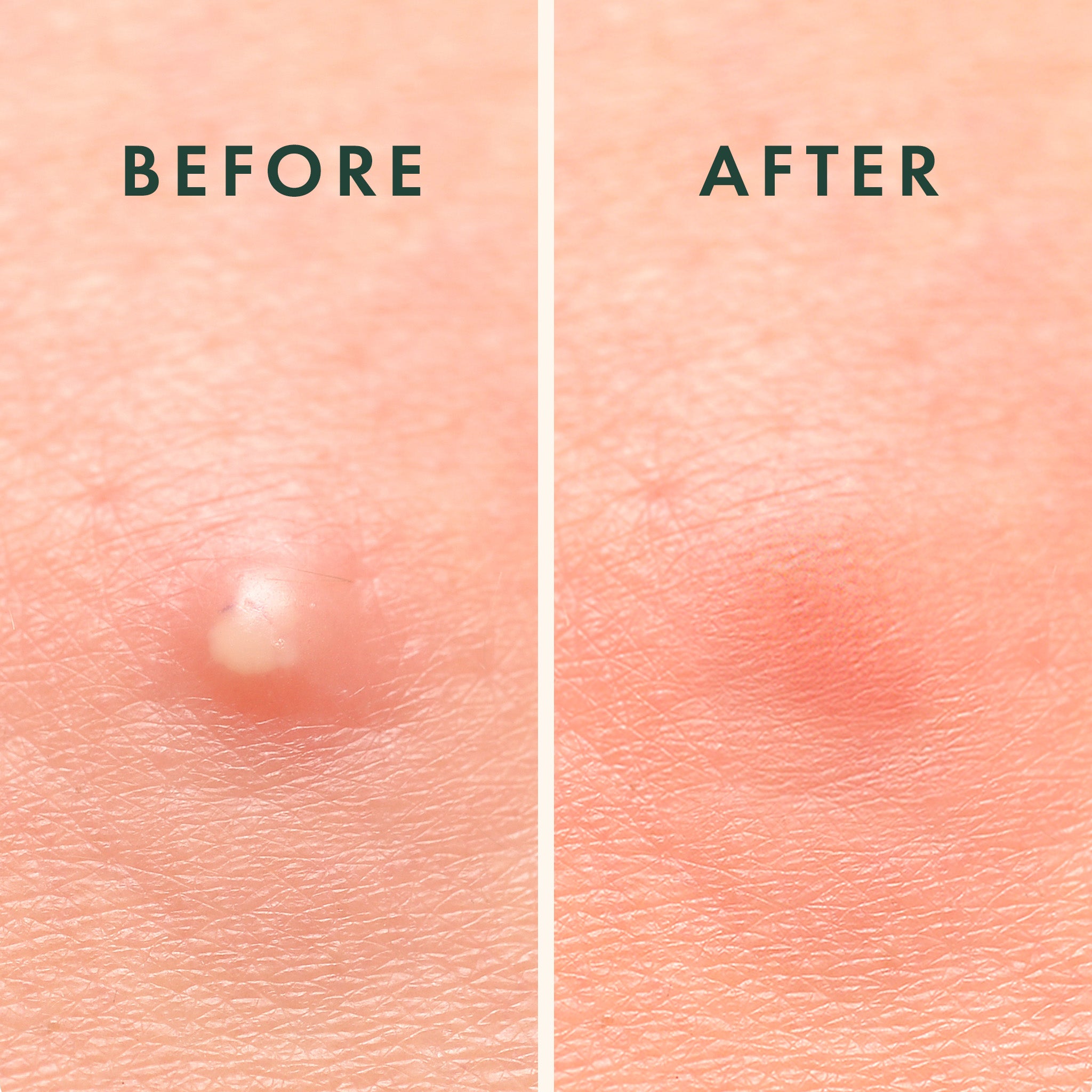To use an acne patch, clean the affected area and apply the patch directly onto the pimple. Keep it on for the recommended duration, usually several hours, to absorb pus and reduce inflammation.
Acne patches, or hydrocolloid dressings, offer a discreet and effective way to treat unsightly pimples. They work by creating a moist environment, which speeds up the healing process and protects the spot from external bacteria and further infection. Ideal for those seeking a targeted acne treatment, these patches are typically infused with ingredients like salicylic acid or tea tree oil to enhance their healing properties.
They’re simple to use: start with a clean face, peel off a patch, and place it firmly over the blemish. The ease of use and convenience make acne patches a popular choice among people of all ages struggling with occasional breakouts or chronic acne.

Credit: www.amazon.com
Introduction To Acne Patches
Acne patches are a game-changer in skincare. These small, round patches act as a shield, protecting blemishes from bacteria and dirt. Not only do they help prevent acne from getting worse, but they also treat the pimples by absorbing excess oil and pus. Let’s dive into what these patches are and the benefits they offer.
What Are Acne Patches?
Acne patches, also known as pimple patches, are small, sticky hydrocolloid bandages. They stick to the skin and create a moist environment, which helps to heal acne faster. Typically, they are transparent or flesh-toned, making them less noticeable on the skin.
Benefits Of Using Acne Patches
- Protects the affected area from external irritants and contamination
- Reduces inflammation and redness
- Prevents scarring by reducing the urge to pick at pimples
- Absorbs gunk like pus and oil, promoting faster healing
- Drug-free solution, suitable for sensitive skin types
- Easy to use and can be worn under makeup
Types Of Acne Patches
Fighting acne just got easier with acne patches. These tiny, discrete stickers can work magic overnight. They come in different types. Let’s explore them.
Hydrocolloid Patches
Hydrocolloid patches are like mini sponges for your pimples. They absorb fluid and pus, flattening and healing acne faster. These patches protect the affected area from bacteria and prevent picking or touching, which can lead to scarring.
- Keeps area clean
- Reduces inflammation
- Prevents scarring
Medicated Patches
Medicated patches contain active ingredients like salicylic acid or tea tree oil. These ingredients target acne-causing bacteria and help reduce redness and swelling. Perfect for those who want an extra healing boost.
| Ingredient | Benefit |
|---|---|
| Salicylic Acid | Unclogs pores |
| Tea Tree Oil | Fights bacteria |
Microneedle Patches
Microneedle patches are the latest innovation. They have tiny needles that gently penetrate the skin. This delivers acne-fighting ingredients directly to the source. Ideal for deep cystic acne.
- Gentle penetration
- Direct ingredient delivery
- Targets deep acne
Choosing The Right Acne Patch
Finding the perfect acne patch can feel like a daunting task. With various types and brands available, it’s essential to select one that suits your skin’s specific needs. To help you navigate this decision, consider two critical factors: your skin type and the type of acne you’re dealing with. By understanding these elements, you’ll be better equipped to choose an acne patch that can effectively help clear your blemishes.
Assess Your Skin Type
To select an acne patch that works best for you, first, identify your skin type. This is important because different patches cater to different skin concerns. Use the table below to determine which type of patch is suitable for your skin:
| Skin Type | Recommended Patch Type |
|---|---|
| Oily Skin | Patches with strong adhesion and oil-absorbing properties |
| Dry Skin | Hydrating patches with gentler adhesion |
| Sensitive Skin | Hypoallergenic patches to minimize irritation |
| Combination Skin | Versatile patches that balance oil absorption and hydration |
Note: Always test a new patch on a small area first to ensure no adverse reactions occur.
Identify The Type Of Acne
Different acne types require different patches. An effective acne patch should target the specific kind of pimple you have. Here’s a simple guide:
- Whiteheads: Look for patches that can help extract the pus without popping the pimple.
- Blackheads: Use patches designed to dissolve or lift the blackhead from the pore.
- Cystic Acne: Choose patches with active ingredients like salicylic acid to penetrate deeper layers.
- Inflamed Pimples: Opt for patches with soothing ingredients to reduce redness and swelling.
Remember, the right patch can speed up healing and prevent scarring. Take your time to read the labels and choose wisely.

Credit: wishtrend.com
Preparation Before Application
Getting ready to use an acne patch is important. Clean skin makes the patch work better. Let’s get your skin ready for the patch.
Cleanse Your Skin
Start with a clean slate. Use a gentle cleanser to remove dirt and oil. Avoid harsh scrubs or soaps. They can irritate your skin. Pat your face with a soft towel. Be gentle to your skin.
Dry The Affected Area
Moisture can stop the patch from sticking. Make sure the spot is dry. Use a clean towel or let it air dry. Do not rub the area. Once it’s dry, you’re ready for the next step.
Applying The Acne Patch
Acne patches are a game-changer for blemish treatment. They shield pimples from bacteria and help heal them fast. Let’s dive into how to apply these patches correctly for the best results.
Placement Techniques
Knowing where and how to place an acne patch is key. Follow these steps:
- Start with a clean face. Use gentle soap and water.
- Dry your skin thoroughly. Patches stick better on dry skin.
- Choose the right size patch for the pimple.
- Peel off the patch from its sheet gently.
- Center the patch over the pimple. Press it down for a few seconds.
Ensuring Good Adhesion
For a patch to work, it must stick well. Here’s how to make sure it does:
- Avoid moisturizers or makeup on the pimple before applying the patch.
- Press firmly on the patch for 5-10 seconds.
- Check the edges for any lifting. Press down if needed.
- Leave the patch on for at least 6 hours, or as instructed.
Follow these tips and your acne patch will stay put, working its magic as you go about your day or rest at night.
Aftercare And Monitoring
Once an acne patch is in place, proper aftercare is crucial. Monitoring the healing process helps ensure effective treatment. Let’s dive into the specifics of aftercare and how to recognize the signs of healing.
How Long To Leave The Patch On
Time is key for acne patch effectiveness. Most patches should remain on for at least 6 hours. Some can stay on up to 24 hours. Always follow the product’s instructions. Replace the patch if it turns opaque, indicating it has absorbed pus and impurities. Use a new patch if acne persists.
Signs Of Healing
Recognizing healing signs is essential. Look for these indicators:
- Reduced redness around the acne spot.
- A flatter lesion, showing the patch has drawn out fluids.
- Less pain when touching the affected area.
- The patch turns white or cloudy, trapping the impurities.
If the spot looks unimproved or worse after several patches, consult a dermatologist. Remember, acne patches are a spot treatment and part of a broader skincare routine.
Common Mistakes To Avoid
Acne patches are an easy fix for pesky pimples. Yet, some common mistakes can reduce their effectiveness. Let’s explore these errors and learn how to avoid them for better results.
Using On Unwashed Skin
Always clean your skin before applying an acne patch. Dirt and oil on your face can block the patch’s active ingredients from reaching the pimple. This mistake can prevent the patch from working well.
- Wash your face with a gentle cleanser.
- Pat your skin dry with a clean towel.
- Apply the acne patch on dry skin.
Reusing Patches
Never reuse an acne patch. A used patch won’t be as effective and can spread bacteria, leading to more breakouts.
| Do This | Not This |
|---|---|
| Use a new patch for each pimple. | Reuse old patches. |
| Dispose of the patch after use. | Save patches for later use. |
Faqs About Acne Patches
Welcome to our section on FAQs About Acne Patches. Here, we answer common questions and provide crucial information to help you use acne patches effectively.
Can Acne Patches Cure Cystic Acne?
Acne patches are best for mild to moderate acne. They are not a cure for cystic acne, which is deeper and often more severe. Cystic acne typically requires treatment that can penetrate deeper into the skin. Consult a dermatologist for the best treatment options.
Are There Any Side Effects?
- Redness: Some users may notice slight redness after removing the patch.
- Irritation: Rarely, a patch can irritate sensitive skin.
- Allergic reactions: Check ingredients if you have allergies.
Always perform a patch test on a small skin area before full use.

Credit: www.getrael.com
Frequently Asked Questions
How Long Do You Leave An Acne Patch On?
Leave an acne patch on for 6 to 8 hours, typically overnight, to allow it to absorb pus and reduce inflammation effectively. Always follow the specific product instructions for optimal results.
Do You Pop The Pimple Before Putting On The Patch?
No, do not pop the pimple before applying the patch. Cleanse the area and apply the patch to intact skin for best results.
Do Pimple Patches Work On Unpopped Pimples?
Yes, pimple patches can work on unpopped pimples by absorbing pus and reducing inflammation, thus promoting healing.
Do Pimple Patches Really Work?
Yes, pimple patches can be effective. They work by absorbing pus and protecting the area, which may reduce inflammation and speed up healing.
Conclusion
Embracing the simplicity of acne patches can transform your skincare routine. They target trouble spots with precision, reducing inflammation and promoting healing overnight. Remember to apply them to clean, dry skin for the best results. With consistent use, these tiny wonders offer a discreet, potent defense against pesky breakouts.
Give them a try and witness your skin’s journey to clarity.

